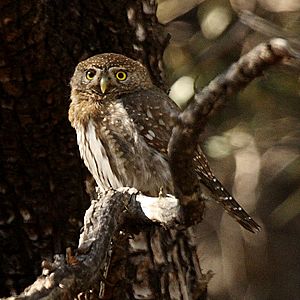Northern pygmy owl facts for kids
Quick facts for kids Northern pygmy owl |
|
|---|---|
 |
|
| A "mountain" pygmy owl in southeastern Arizona. | |
| Conservation status | |
| Scientific classification | |
| Kingdom: | |
| Phylum: | |
| Class: | |
| Order: | |
| Family: | |
| Genus: |
Glaucidium
|
| Binomial name | |
| Glaucidium gnoma |
|
The Northern pygmy owl (Glaucidium gnoma) is a small owl native to North and Central America.
Contents
Description
The Northern pygmy owl is small and has a long tail. It has shiny yellow eyes, yellow feet, and small tuffs of fur with its ears. Its feathers are a reddish brown speckled with white. Like all of the members of its family, it has fake eye spots that are black and outlined in white on the back of its neck. The Northern Pygmy Owl's stomach is white with black stripes. The Northern Pygmy Owl tends to perch in a diagonal position rather than an upright position.
Breeding
Northern pygmy owls nest and breed in evergreen-filled forests and woodlands with variety. They normally mate in Spring. They prefer to live in tree cavities or old woodpeckers' holes. They do not add anything to their nest. The mothers keep three or four eggs warm. But she waits for all of the eggs to be laid before she starts incubating. That is an inimitable trait of northern American owls. While the female owl takes care of the eggs, the male consistently brings food for them. After the eggs hatch, the mother takes care of them for about one week. The baby owls will gain the ability to fly in about twenty-seven to twenty-eight days.
Habitat
Northern pygmy owls are widespread across North America. They usually live in the scattered areas with less trees, rather than large parts of land with lots of unbroken trees. Northern pygmy owls are most active during the dawn or the dusk. Northern pygmy owls can also be seen in the daytime, when the weather is overcast. They like to perch on conifer or small trees, or in a snag. When they perch, they bob their head up and down, and flick their tails, and hold their tails to one side.
Diet
One third of the pygmy owls' diet are rodents, large insects, and small birds. Northern pygmy owls are very aggressive hunters, so fast that they can catch their prey in flight.
Adaptations
Adaptations are like special tools or features that animals have developed over a very long time to help them live and thrive in their specific environment.
The Northern Pygmy Owl has several amazing adaptations that make it a successful hunter.
- Excellent Eyesight
- Sharp Hearing
- Silent Flight
- False Eyes: This is a fascinating adaptation! The black patches on the back of their neck look like eyes. Scientists believe these "false eyes" might trick potential predators into thinking the owl is looking at them, even when its head is turned away. This could make a predator hesitate, giving the owl a chance to escape.
- Perch Hunting: Northern Pygmy Owls often hunt by perching on a branch and scanning the area below and around them. This saves energy compared to constantly flying around searching for food.
- Camouflage: Their brown and gray speckled feathers blend in very well with the bark of trees and the shadows of the forest. This natural camouflage helps them hide from both predators and potential prey.
Predators
The Northern Pygmy Owl has several natural predators in its environment.
- Larger Owls: Great horned owls, for example, are much larger and powerful and are known to hunt smaller owls.
- Hawks and Falcons: Diurnal birds of prey, like Cooper's hawks, Northern goshawks, and Peregrine falcons, are active during the day when the Northern pygmy owl is also hunting. These birds are fast and agile flyers and will prey on smaller birds, including pygmy owls.
- Mammals: Some mammals can also be predators, especially if they find a nest or catch an owl on the ground. Examples might include: weasels, pine martens, squirrels (sometimes prey on eggs or young), domestic cats (in areas where habitats overlap).
- Crows and Jays: While not always direct predators of adult owls, birds like crows and jays are known to "mob" or harass owls they find. They do this to drive the owl away from their territory, especially if the owl is seen as a threat to their own nests or young.
See also
 In Spanish: Mochuelo californiano para niños
In Spanish: Mochuelo californiano para niños


